Exploring the Influence of the Deposition Parameters on the Properties of NiTi Shape Memory Alloy Films with High Nickel Content
Abstract
1. Introduction
2. Materials and Methods
2.1. Deposition Technique
2.2. Characterization Techniques
3. Results and Discussion
3.1. As-Deposited Films
3.2. Heat-Treated Films
3.3. Mechanical Behavior
4. Conclusions
Author Contributions
Funding
Institutional Review Board Statement
Informed Consent Statement
Data Availability Statement
Acknowledgments
Conflicts of Interest
References
- Khanlari, K.; Ramezani, M.; Kelly, P. 60NiTi: A Review of Recent Research Findings, Potential for Structural and Mechanical Applications, and Areas of Continued Investigations. Trans. Indian Inst. Met. 2018, 71, 781–799. [Google Scholar] [CrossRef]
- Xu, G.X.; Zheng, L.J.; Zhang, F.X.; Zhang, H. Influence of solution heat treatment on the microstructural evolution and mechanical behavior of 60NiTi. J. Alloys Compd. 2019, 775, 698–706. [Google Scholar] [CrossRef]
- Zhang, F.; Zheng, L.; Wang, F.; Zhang, H. Effects of Nb additions on the precipitate morphology and hardening behavior of Ni-rich Ni55Ti45 alloys. J. Alloys Compd. 2018, 735, 2453–2461. [Google Scholar] [CrossRef]
- Khanlari, K.; Shi, Q.; Li, K.; Hu, K.; Tan, C.; Zhang, W.; Cao, P.; Achouri, I.E.; Liu, X. Fabrication of Ni-Rich 58NiTi and 60NiTi from Elementally Blended Ni and Ti Powders by a Laser Powder Bed Fusion Technique: Their Printing, Homogenization and Densification. Int. J. Mol. Sci. 2022, 23, 9495. [Google Scholar] [CrossRef] [PubMed]
- Li, Y.; Dai, J.; Song, Y. Research Progress of First Principles Studies on Oxidation Behaviors of Ti-Al Alloys and Alloying Influence. Metals 2021, 11, 985. [Google Scholar] [CrossRef]
- Tillmann, W.; Momeni, S. In-situ annealing of NiTi thin films at different temperatures. Sens. Actuators A Phys. 2015, 221, 9–14. [Google Scholar] [CrossRef]
- Sharma, S.K.; Mohan, S. Influence of annealing on structural, morphological, compositional and surface properties of magnetron sputtered nickel–titanium thin films. Appl. Surf. Sci. 2013, 282, 492–498. [Google Scholar] [CrossRef]
- Otsuka, K.; Ren, X. Physical metallurgy of Ti–Ni-based shape memory alloys. Prog. Mater. Sci. 2005, 50, 511–678. [Google Scholar] [CrossRef]
- Young, M.L.; Wagner, M.-X.; Frenzel, J.; Schmahl, W.W.; Eggeler, G. Phase volume fractions and strain measurements in an ultrafine-grained NiTi shape-memory alloy during tensile loading. Acta Mater. 2010, 58, 2344–2354. [Google Scholar] [CrossRef]
- Thornton, J.A. The microstructure of sputter-deposited coatings. J. Vac. Sci. Technol. A Vac. Surf. Film. 1986, 4, 3059–3065. [Google Scholar] [CrossRef]
- Tillmann, W.; Momeni, S. Deposition of superelastic composite NiTi based films. Vacuum 2014, 104, 41–46. [Google Scholar] [CrossRef]
- Bai, X.; Cai, Q.; Xie, W.; Zeng, Y.; Chu, C.; Zhang, X. In-situ crystalline TiNi thin films deposited by HiPIMS at a low substrate temperature. Surf. Coat. Technol. 2023, 455, 129196. [Google Scholar] [CrossRef]
- Kumar, A.; Singh, D.; Kaur, D. Grain size effect on structural, electrical and mechanical properties of NiTi thin films deposited by magnetron co-sputtering. Surf. Coat. Technol. 2009, 203, 1596–1603. [Google Scholar] [CrossRef]
- Fu, Y.; Huang, W.; Du, H.; Huang, X.; Tan, J.; Gao, X. 26 Characterisation of TiNi Shape-Memory Alloy Thin Films for MEMS Applications. Surf. Coat. Technol. 2001, 145, 107–112. [Google Scholar] [CrossRef]
- Marupalli, B.C.G.; Behera, A.; Aich, S. A Critical Review on Nickel–Titanium Thin-Film Shape Memory Alloy Fabricated by Magnetron Sputtering and Influence of Process Parameters. Trans. Indian Inst. Met. 2021, 74, 2521–2540. [Google Scholar] [CrossRef]
- Oliver, W.C.; Pharr, G.M. Measurement of hardness and elastic modulus by instrumented indentation: Advances in understanding and refinements to methodology. J. Mater. Res. 2004, 19, 3–20. [Google Scholar] [CrossRef]
- Logothetidis, S.; Charitidis, C. Elastic properties of hydrogen-free amorphous carbon thin films and their relation with carbon–carbon bonding. Thin Solid Films 1999, 353, 208–213. [Google Scholar] [CrossRef]
- Fasaki, I.; Koutoulaki, A.; Kompitsas, M.; Charitidis, C. Structural, electrical and mechanical properties of NiO thin films grown by pulsed laser deposition. Appl. Surf. Sci. 2010, 257, 429–433. [Google Scholar] [CrossRef]
- Hammersley, A.P.; Svensson, S.O.; Hanfland, M.; Fitch, A.N.; Hausermann, D. Two-dimensional detector software: From real detector to idealised image or two-theta scan. High Press. Res. 1996, 14, 235–248. [Google Scholar] [CrossRef]
- Shih, C.-L.; Lai, B.-K.; Kahn, H.; Phillips, S.M.; Heuer, A.H. A robust co-sputtering fabrication procedure for TiNi shape memory alloys for MEMS. J. Microelectromech. Syst. 2001, 10, 69–79. [Google Scholar] [CrossRef]
- Tillmann, W.; Momeni, S. Comparison of NiTi thin films sputtered from separate elemental targets and Ti-rich alloy targets. J. Mater. Process. Technol. 2015, 220, 184–190. [Google Scholar] [CrossRef]
- Miyazaki, S.; Ishida, A. Martensitic transformation and shape memory behavior in sputter-deposited TiNi-base thin films. Mater. Sci. Eng. A 1999, 273–275, 106–133. [Google Scholar] [CrossRef]
- Gachon, J.-C.; Rogachev, A.; Grigoryan, H.; Illarionova, E.; Kuntz, J.-J.; Kovalev, D.; Nosyrev, A.; Sachkova, N.; Tsygankov, P. On the mechanism of heterogeneous reaction and phase formation in Ti/Al multilayer nanofilms. Acta Mater. 2005, 53, 1225–1231. [Google Scholar] [CrossRef]
- Apreutesei, M.; Steyer, P.; Billard, A.; Joly-Pottuz, L.; Esnouf, C. Zr–Cu thin film metallic glasses: An assessment of the thermal stability and phases’ transformation mechanisms. J. Alloys Compd. 2015, 619, 284–292. [Google Scholar] [CrossRef]
- Chang, J.-C.; Lee, J.-W.; Lou, B.-S.; Li, C.-L.; Chu, J.P. Effects of tungsten contents on the microstructure, mechanical and anticorrosion properties of Zr–W–Ti thin film metallic glasses. Thin Solid Films 2015, 584, 253–256. [Google Scholar] [CrossRef]
- Rodrigues, P.F.; Fernandes, F.B.; Magalhães, R.; Camacho, E.; Lopes, A.; Paula, A.; Basu, R.; Schell, N. Thermo-mechanical characterization of NiTi orthodontic archwires with graded actuating forces. J. Mech. Behav. Biomed. Mater. 2020, 107, 103747. [Google Scholar] [CrossRef]
- Hou, H.; Hamilton, R.F.; Horn, M.W. Crystallization of nanoscale NiTi alloy thin films using rapid thermal annealing. J. Vac. Sci. Technol. B Nanotechnol. Microelectron. Mater. Process. Meas. Phenom. 2016, 34, 06KK01. [Google Scholar] [CrossRef]
- Somsen, C.; Zähres, H.; Kästner, J.; Wassermann, E.; Kakeshita, T.; Saburi, T. Influence of thermal annealing on the martensitic transitions in Ni–Ti shape memory alloys. Mater. Sci. Eng. A 1999, 273–275, 310–314. [Google Scholar] [CrossRef]
- Otsuka, K.; Wayman, C.M. Mechanism of Shape Memory Effect and Superelasticity. In Shape Memory Materials, 1st ed.; Cambridge University Press: New York, NY, USA, 1998; ISBN 0-521-44487-X. [Google Scholar]
- Yu, H.; Qiu, Y.; Young, M.L. Influence of Ni4Ti3 precipitate on pseudoelasticity of austenitic NiTi shape memory alloys deformed at high strain rate. Mater. Sci. Eng. A 2021, 804, 140753. [Google Scholar] [CrossRef]
- Di Egidio, G. Evaluation by nanoindentation of the influence of heat treatments and the consequent induced microstructure on the mechanical response of the heat-treated L-PBF AlSi10Mg alloy. Metall. Ital. 2022, 6, 8–16. [Google Scholar]
- Ni, W.; Cheng, Y.-T.; Lukitsch, M.; Weiner, A.M.; Lev, L.C.; Grummon, D.S. Novel layered tribological coatings using a superelastic NiTi interlayer. Wear 2005, 259, 842–848. [Google Scholar] [CrossRef]
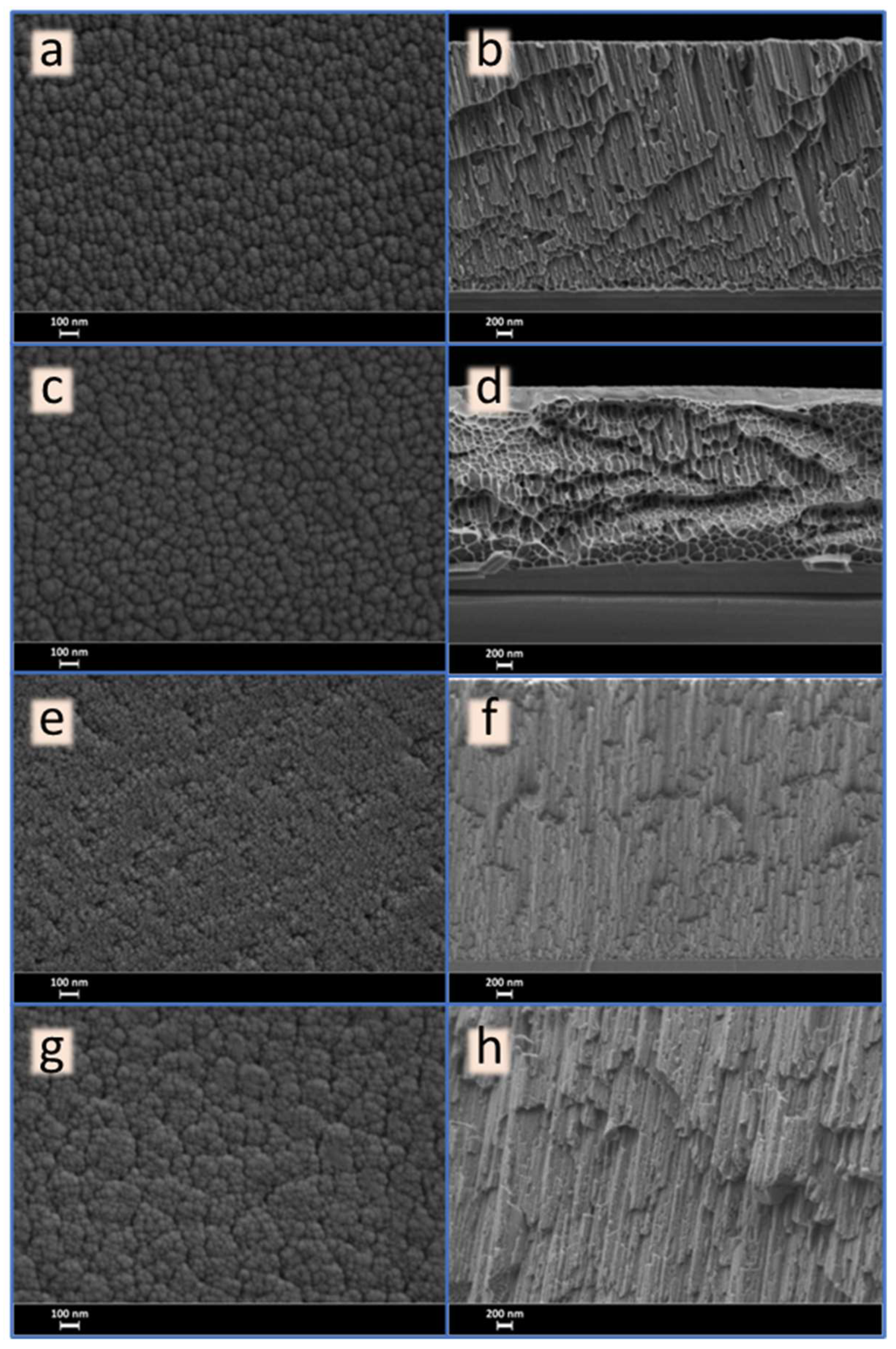
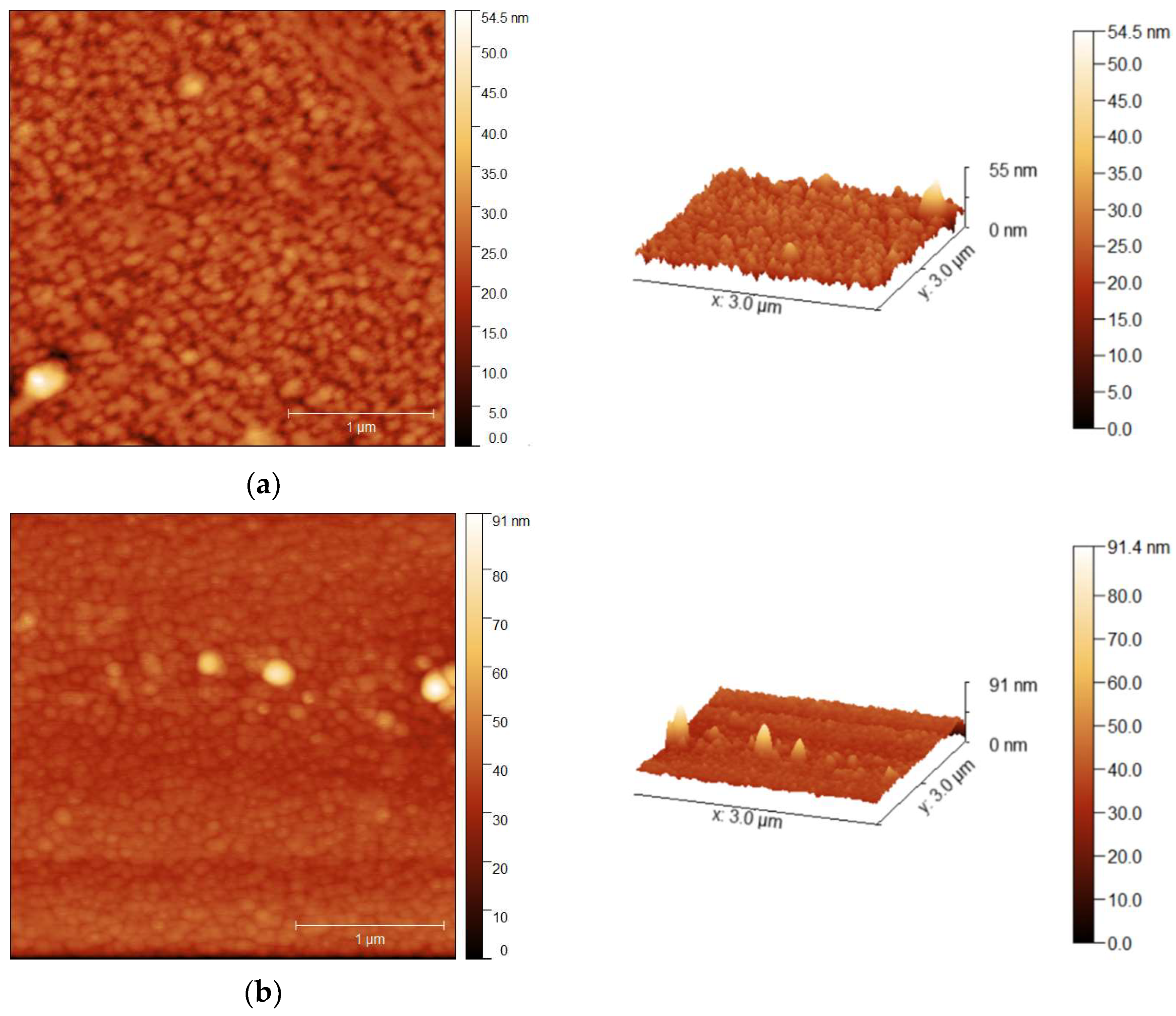
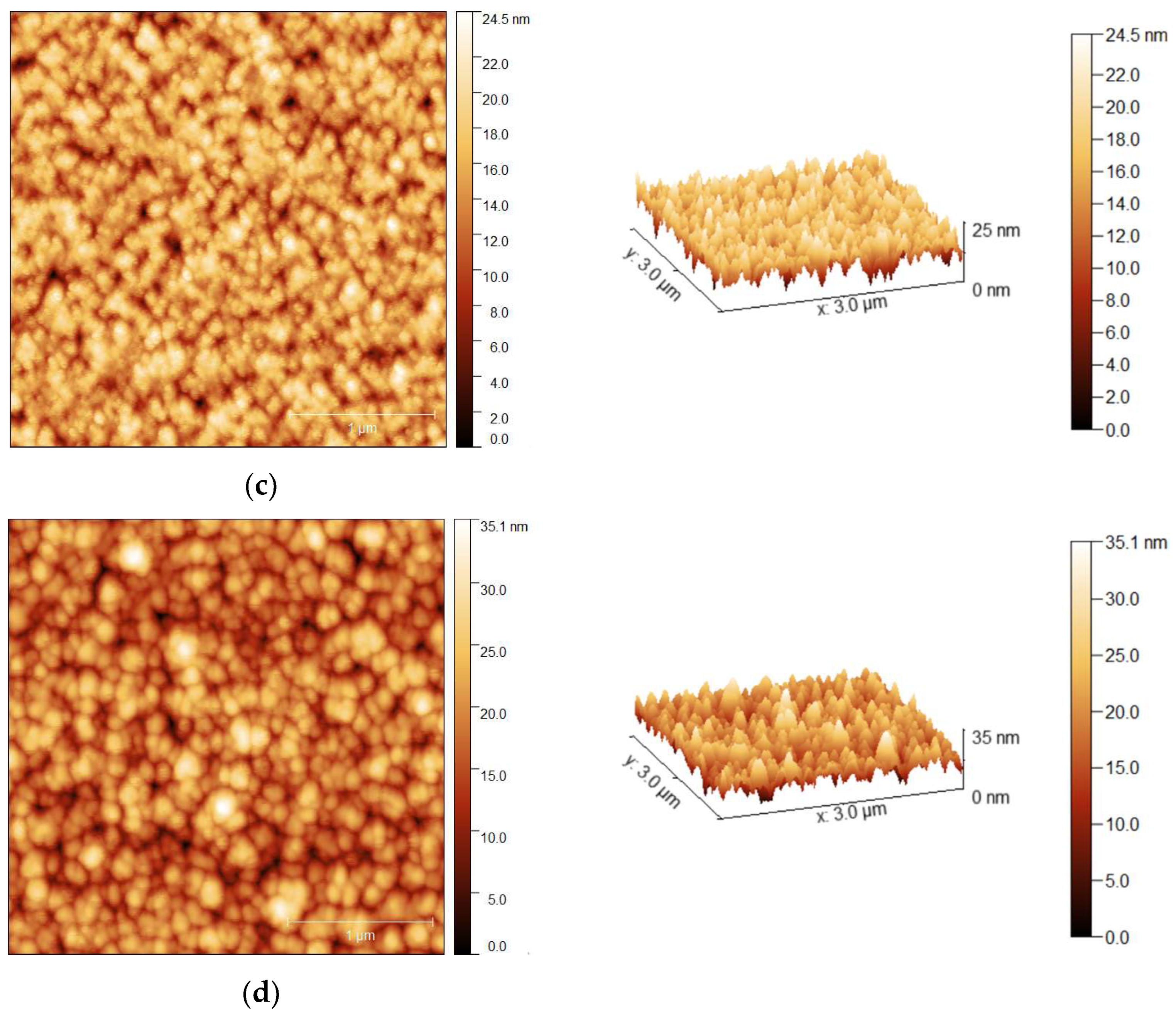
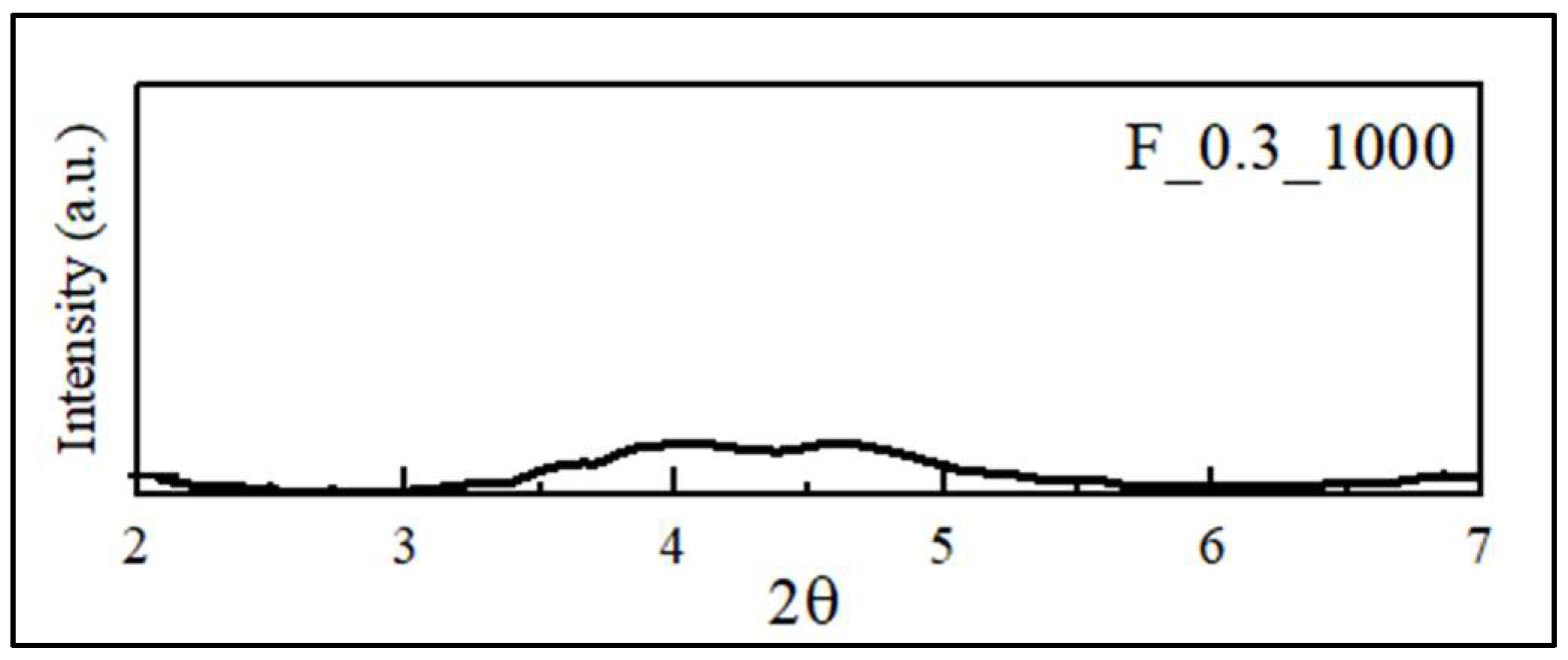
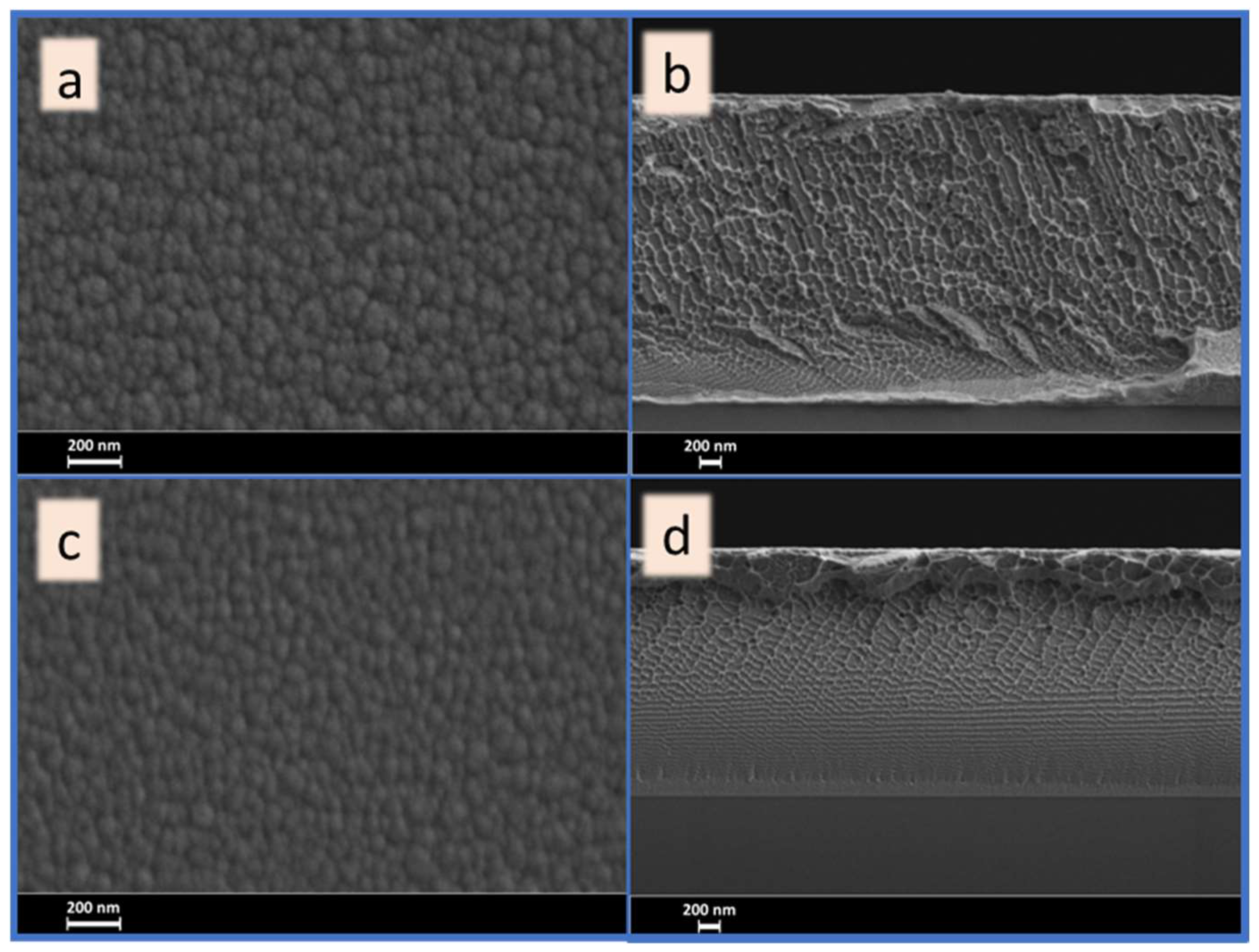
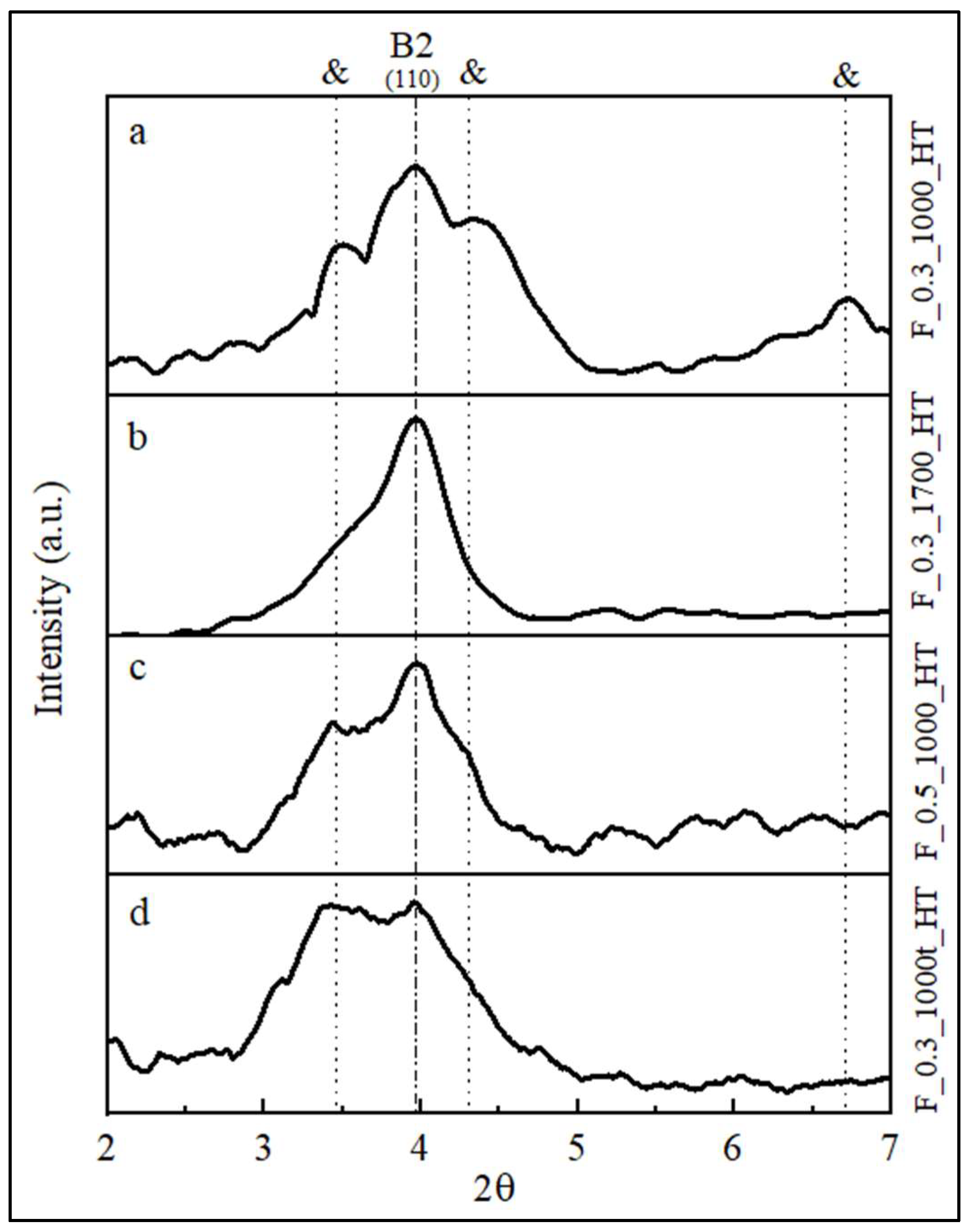
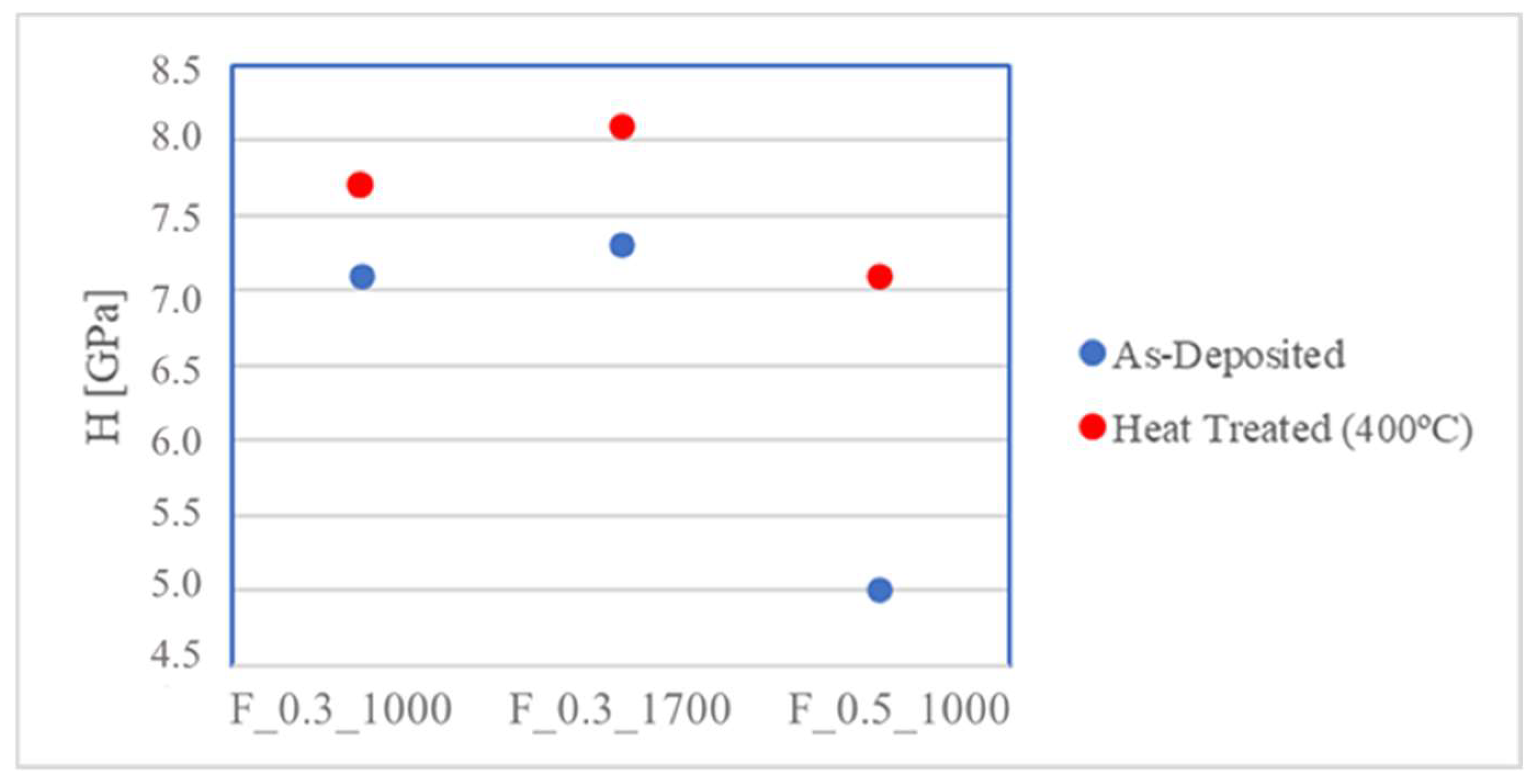
| Film | Target | Pressure [Pa] | Power Density [Wmm−2] | Dep Time [min] | Thickness [μm] |
|---|---|---|---|---|---|
| F_0.3_1000 | NiTi | 0.3 | 4.44 × 10−2 (1000 W) | 60 | 3.2 |
| F_0.3_1700 | NiTi | 0.3 | 7.56 × 10−2 (1700 W) | 28 | 2.7 |
| F_0.5_1000 | NiTi | 0.5 | 4.44 × 10−2 (1000 W) | 60 | 3.4 |
| F_0.3_1000t | NiTi | 0.3 | 4.44 × 10−2 (1000 W) | 120 | 5.1 |
| Film | Ni [at.%] | Ti [at.%] |
|---|---|---|
| F_0.3_1000 | 60.7 ± 0.4 | 39.3 ± 0.4 |
| F_0.3_1700 | 61.4 ± 0.1 | 38.6 ± 0.1 |
| F_0.5_1000 | 60.3 ± 0.3 | 39.7 ± 0.3 |
| F_0.3_1000t | 59.4 ± 0.4 | 40.6 ± 0.4 |
| Film | F_0.3_1000 | F_0.3_1700 | F_0.5_1000 | F_0.3_1000t |
|---|---|---|---|---|
| Sa (nm) | 2.5 ± 0.1 | 2.6 ± 0.4 | 2.6 ± 0.1 | 3.8 ± 0.4 |
| Sq (nm) | 3.4 ± 0.1 | 4.0 ± 0.8 | 3.4 ± 0.3 | 4.9 ± 0.6 |
| Film | Thickness [μm] | Max Depth [nm] | Plastic Depth [nm] | Hardness [GPa] | Er [GPa] | E [GPa] | ERP |
|---|---|---|---|---|---|---|---|
| F_0.3_1000 | 3.2 | 162.1 ± 5.8 | 133.9 ± 6.2 | 7.1 ± 0.5 | 137 ± 8 | 143 ± 8 | 0.211 ± 0.02 |
| F_0.3_1700 | 2.7 | 159.8 ± 6.3 | 131.6 ± 6.7 | 7.3 ± 0.6 | 138 ± 5 | 145 ± 5 | 0.215 ± 0.02 |
| F_0.5_1000 | 3.4 | 193.9 ± 9.4 | 166.1 ± 9.9 | 5.0 ± 0.5 | 116 ± 7 | 119 ± 7 | 0.168 ± 0.02 |
| Film | Max Depth [nm] | Plastic Depth [nm] | Hardness [GPa] | Er [GPa] | E [GPa] | ERP |
|---|---|---|---|---|---|---|
| F_0.3_1000_HT | 154.8 ± 6.9 | 126.7 ± 6,8 | 7.7 ± 0.7 | 143 ± 9 | 151 ± 9 | 0.222 ± 0.02 |
| F_0.3_1700_HT | 150.6 ± 4.6 | 122.6 ± 5.0 | 8.1 ± 0.6 | 147 ± 6 | 156 ± 6 | 0.229 ± 0.02 |
| F_0.5_1000_HT | 160.6 ± 5.1 | 133.0 ± 5.8 | 7.1 ± 0.5 | 140 ± 5 | 147 ± 5 | 0.208 ± 0.02 |
Disclaimer/Publisher’s Note: The statements, opinions and data contained in all publications are solely those of the individual author(s) and contributor(s) and not of MDPI and/or the editor(s). MDPI and/or the editor(s) disclaim responsibility for any injury to people or property resulting from any ideas, methods, instructions or products referred to in the content. |
© 2024 by the authors. Licensee MDPI, Basel, Switzerland. This article is an open access article distributed under the terms and conditions of the Creative Commons Attribution (CC BY) license (https://creativecommons.org/licenses/by/4.0/).
Share and Cite
Fontes, A.V.; Freitas Rodrigues, P.; Santo, D.; Ramos, A.S. Exploring the Influence of the Deposition Parameters on the Properties of NiTi Shape Memory Alloy Films with High Nickel Content. Coatings 2024, 14, 138. https://doi.org/10.3390/coatings14010138
Fontes AV, Freitas Rodrigues P, Santo D, Ramos AS. Exploring the Influence of the Deposition Parameters on the Properties of NiTi Shape Memory Alloy Films with High Nickel Content. Coatings. 2024; 14(1):138. https://doi.org/10.3390/coatings14010138
Chicago/Turabian StyleFontes, André V., Patrícia Freitas Rodrigues, Daniela Santo, and Ana Sofia Ramos. 2024. "Exploring the Influence of the Deposition Parameters on the Properties of NiTi Shape Memory Alloy Films with High Nickel Content" Coatings 14, no. 1: 138. https://doi.org/10.3390/coatings14010138
APA StyleFontes, A. V., Freitas Rodrigues, P., Santo, D., & Ramos, A. S. (2024). Exploring the Influence of the Deposition Parameters on the Properties of NiTi Shape Memory Alloy Films with High Nickel Content. Coatings, 14(1), 138. https://doi.org/10.3390/coatings14010138








